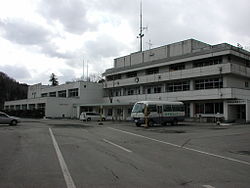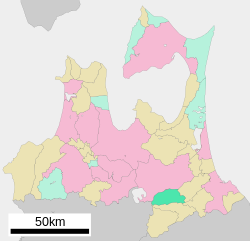Shingō, Aomori
Shingō
新郷村 | |
|---|---|
 Shingō Village Office | |
 Location of Shingō in Aomori Prefecture | |
 | |
| Coordinates: 40°27′49.19″N 141°10′27.53″E / 40.4636639°N 141.1743139°E | |
| Country | Japan |
| Region | Tōhoku |
| Prefecture | Aomori |
| District | Sannohe |
| Area | |
| • Total | 150.77 km2 (58.21 sq mi) |
| Population (February 28, 2023) | |
| • Total | 2,192 |
| • Density | 15/km2 (38/sq mi) |
| Time zone | UTC+9 (Japan Standard Time) |
| Phone number | 0178-78-2111 |
| Address | 039-0801 |
| Website | Official website |
| Symbols | |
| Flower | Asian skunk cabbage |
| Tree | Aesculus |
Shingō (新郷村, Shingō-mura) is a village located in Aomori Prefecture, Japan. As of 28 February 2023[update], the village has an estimated population of 2,192 in 895 households[1] and a population density of 15 persons per km2 (42 people per square mile). The total area of the village is 150.77 square kilometres (58.21 sq mi).[2]
Geography
[edit]Shingō is in south-central Aomori Prefecture, east of Lake Towada. The western edge of the village borders Akita Prefecture. Much of the village is mountainous with the outer ring mountains of Lake Towada, including Mt. Okomagatake (1,144 metres (3,753 ft)) and Mt. Toraidake (1,159 m (3,802 ft)). The village area extends along National Route 454, which connects Hachinohe, Aomori Prefecture and Lake Towada.
Neighboring municipalities
[edit]Climate
[edit]The village has a cold humid continental climate characterized by cool short summers and long cold winters with very heavy snowfall (Köppen climate classification Dfa). The average annual temperature in Shingō is 8.7 °C (47.7 °F). The average annual rainfall is 1,342 mm (52.8 in), with September as the wettest month. The temperatures are highest on average in August, at around 22.2 °C (72.0 °F), and lowest in January, at around −3.7 °C (25.3 °F).[3]
Demographics
[edit]Per Japanese census data,[4] the population of Shingō has declined steadily over the past 70 years.
| Year | Pop. | ±% p.a. | ||
|---|---|---|---|---|
| 1950 | 6,411 | — | ||
| 1960 | 6,409 | −0.00% | ||
| 1970 | 4,754 | −2.94% | ||
| 1980 | 4,332 | −0.93% | ||
| 1990 | 3,724 | −1.50% | ||
| 2000 | 3,343 | −1.07% | ||
| 2010 | 2,851 | −1.58% | ||
| 2020 | 2,197 | −2.57% | ||
| ||||
History
[edit]The area around Shingō was controlled by the Nanbu clan of Morioka Domain during the Edo period. During the post-Meiji Restoration establishment of the modern municipalities system on 1 April 1889, Herai Village and neighboring Nozawa Village were formed. On 29 July 1955, the western portion of Nozawa Village merged into Herai, which was then renamed Shingō.
Government
[edit]Shingō has a mayor-council form of government with a directly elected mayor and a unicameral village council of eight members. Shingō is part of Sannohe District which contributes three members to the Aomori Prefectural Assembly. In terms of national politics, the village is part of Aomori 2nd district of the House of Representatives of the National Diet.
Education
[edit]Shingō has one public elementary school, one public middle school, and a preschool operated by the village government. The village does not have a high school.
Economy
[edit]The economy of Shingō is heavily dependent on agriculture. Notable crops include garlic, edible chrysanthemum, Japanese yam and tobacco. Traditionally a horse breeding area, Shingō is also known for its cattle ranches.
Transportation
[edit]Railway
[edit]- The village has no passenger railway service. The nearest train station is JR East Hachinohe Station, served by the Tohoku Shinkansen and Hachinohe Lines, and the Aoimori Railway Aoimori Railway Line.
Highway
[edit]"Tomb of Jesus"
[edit]
Shingō is the location of what is purported to be the resting place of Jesus, the "Tomb of Christ" (Kirisuto no haka), and the residence of Jesus' descendants, the Sawaguchi family.[5] According to these claims, Jesus Christ did not die on the cross at Golgotha. Instead, a man alleged to be his brother, Isukiri,[6] took his place on the cross, while Jesus escaped across Siberia to Mutsu Province, in northern Japan. Once in Japan, Jesus changed his name to Torai Tora Daitenku and became a garlic farmer. In Japan, Jesus allegedly married a woman named Miyuko, with whom he fathered three children, all daughters. The eldest daughter married into the Sawaguchi family, which is claimed to hold a direct lineage to Jesus, evidenced by certain non-Japanese physical characteristics. After his death at an age exceeding 100, Jesus was said to have been interred into one of two grave mounds in the village. A remnant of the crucified Isukiri, his ear, and a lock of hair that belonged to his mother, is allegedly buried in the other mound.[7]
Few people seem to believe in the legend at face value, especially as many of the details come from the controversial Takenouchi documents (竹内文書, Takenouchi no Sukune), which are believed by most scholars to be a hoax. These documents report that Jesus studied Buddhism in Japan in the time between his childhood and the start of his ministry, and that his teachings in the New Testament were rooted in ancient Buddhist wisdom. These documents were reportedly destroyed during World War II, making verification of their authenticity impossible. Some[who?] theorize that the legend originated from 17th century Jesuit missionaries. Following the outlawing of Christianity in Japan, these missionaries, as well as Japanese Catholic converts, were persecuted and driven into hiding.

A Christian church, repurposed into a Legend of Christ Museum, currently sits at the Tomb of Christ site in Shingō and can be visited for a ¥100 entrance fee. This museum includes displays and artifacts detailing the different elements of the legend and daily life in Shingō over history. The museum claims that many of the unique customs of the village, like the now-lost custom of drawing a cross on the forehead of infants, come directly from the teachings and direction of Jesus. Each year, a festival (matsuri) is held at the site on the first Sunday of June.[8] Thousands of pilgrims and tourists travel to the site annually, making it the small village's primary source of tourism.[9]
References
[edit]- ^ "Shingō village official statistics" (in Japanese). Japan.
- ^ 詳細データ 青森県青森県新郷村. 市町村の姿 グラフと統計でみる農林水産業 (in Japanese). Ministry of Agriculture, Forestry and Fisheries. 2016. Retrieved 13 July 2017.
- ^ Shingō climate data
- ^ Shingō population statistics
- ^ "From Japanese text of the sign included in this article". Archived from the original on December 11, 2019.
- ^ "Japan Travel: Jesus in Japan". Metropolis. Archived from the original on 2006-08-25. Retrieved 2006-12-13.
- ^ Palmer, Spencer (April 1, 1970). "Did Christ Visit Japan?". BYU Studies Quarterly. 10 – via Scholars Archive.
- ^ Ryōsuke, Okamoto (March 20, 2019). "Keeping the Faith: Christ's Tomb in Aomori and Japanese Religion". nippon.com. Retrieved November 9, 2021.
- ^ Lidz, Franz. "The Little-Known Legend of Jesus in Japan". Smithsonian Magazine. Retrieved 2021-11-09.
External links
[edit]![]() Media related to Shingō, Aomori at Wikimedia Commons
Media related to Shingō, Aomori at Wikimedia Commons
- Official Website (in Japanese)



